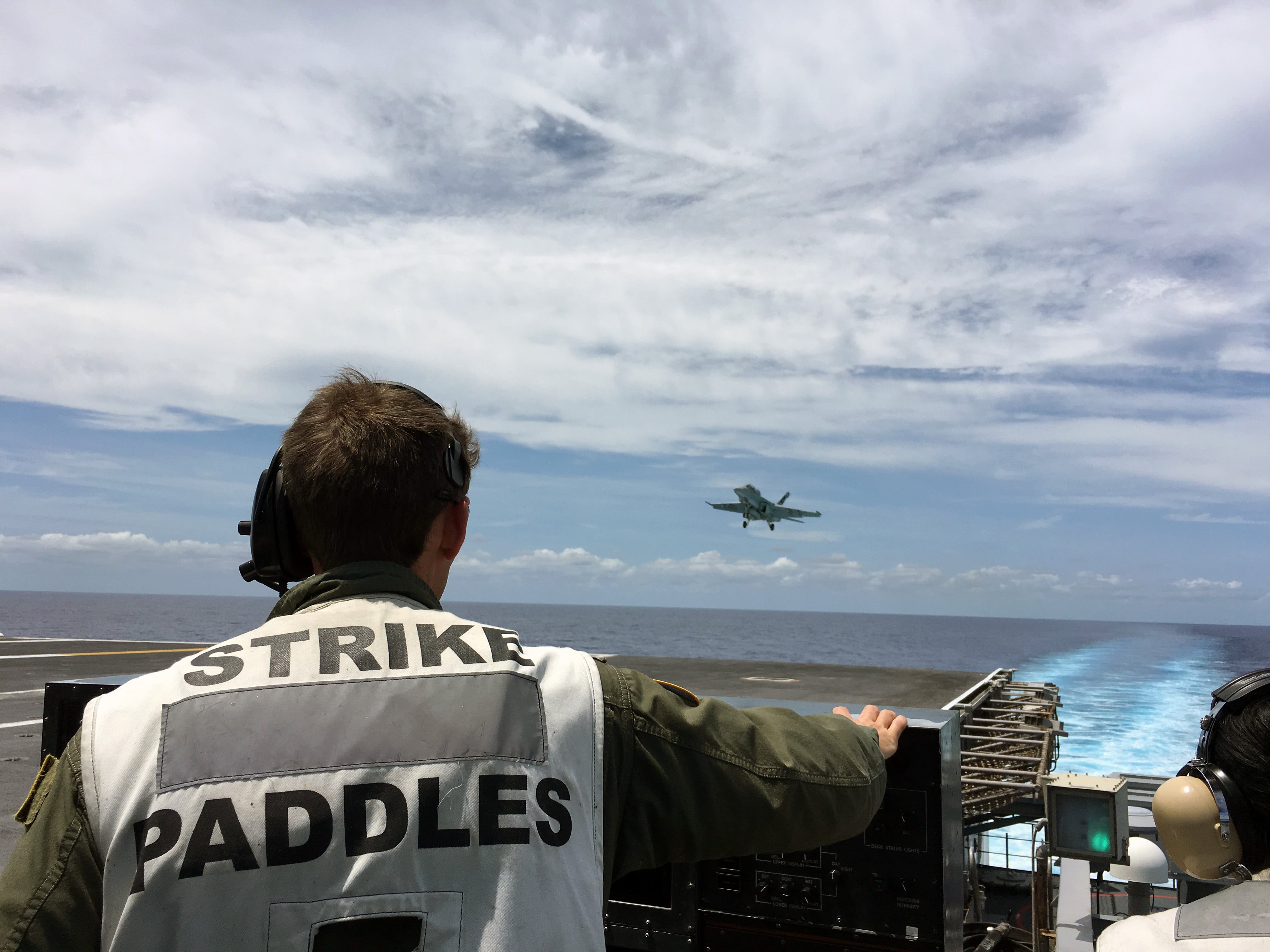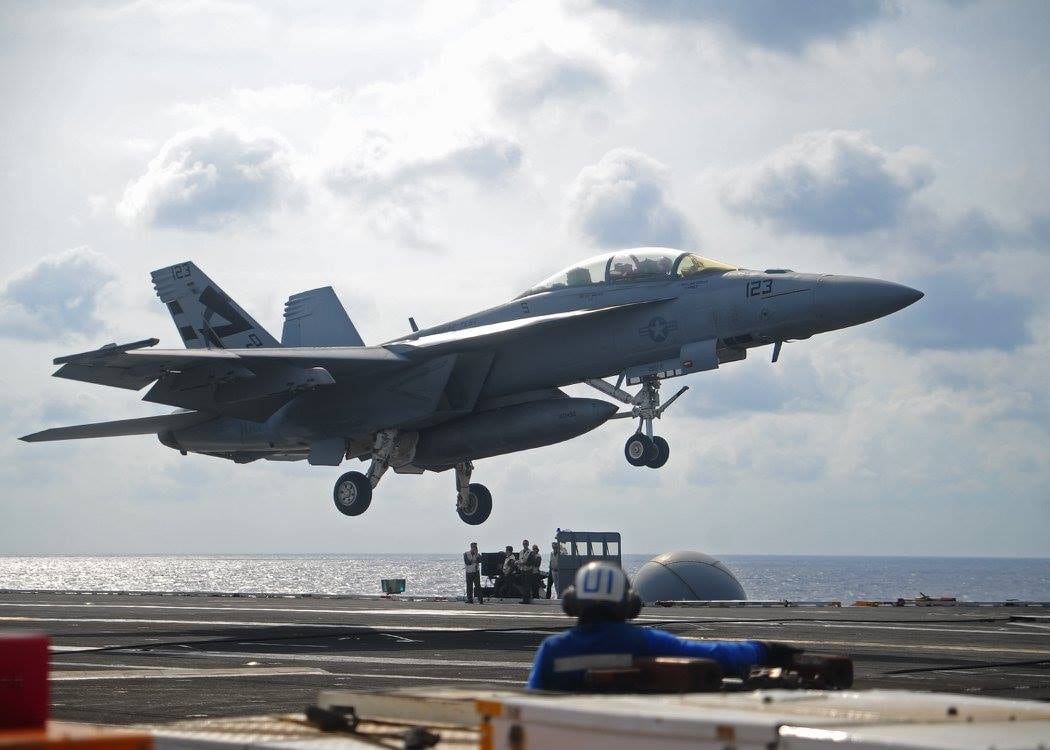ABOARD CARRIER GEORGE WASHINGTON OFF NORFOLK, Va. – In a typical 18-second approach to land on an aircraft carrier landing, a fighter pilot may make up to 300 adjustments with the stick and throttle over 18 seconds before hitting the deck and snagging the jet's tail hook finally setting down on the flight deck and dragging the jet's tail hook just-so across one of four arresting wires.
It's considered one of the most dangerous and stressful jobs in the world because of that landing, but a revolutionary program that's as simple as a software upgrade will take a lot of the scrambling and constant adjustments out of the final seconds of a combat mission.
It's called MAGIC CARPET, and — don't laugh — it stands for Maritime Augmented Guidance with Integrated Controls for Carrier Approach and Recovery Precision Enabling Technologies. What is it does is put jets into a sort of automatic landing mode that guides the plane's trajectory to the deck and reduces the takes many of the frantic adjustments out of the process.
It won't go in the legacy F/A-18A-D Hornets because it the jet's mechanical systems won't respond to this specific software, but for F/A-18E/F Super Hornets and EA-18G Growlers, adding this upgradeprogram could not only make carrier landings safer, but increase efficiency to a point that pilots will need fewer traps to get qualified and stay proficient. As a result, aircraft will take less of a beating and need less maintenance, and more time and effort can be devoted to missions rather than qualifying pilots can focus more on missions than just landing back on the shipand fueling jets.
It will also come standard in the F-35C Lightning II joint strike fighter when it goes operational in 2019.
"Over the next year, we're going to start to look at what kind of checks we can write," Hornet and Growler program manager Capt. David Kindley explained June 27 during an underway to test the program aboard this carrier carrier George Washington.
"I know this is really good, and I think it could be crazy good, but I don't have a sense of the quantity of that," he added.
To properly land a fighter on a carrier, a pilot needs to maintain a 3-degree glide slope, while staying lined up with a moving ship and keeping the jet's nose at just the right angle so it doesn't slam into the deck.
To do This requires constant movement of their controls — left and right with the stick for the right direction, back and forth to put the nose up or down, and constant acceleration and deceleration with the throttle to make up for any power lost with all that moving around.
But with Magic Carpet, a flight control software program developed by Navy engineers in-house at Naval Air Systems Command, all of those controls have been decoupled.
Now, Kindley said, the jet will self-adjust to stay on that 3-degree path.
"What we do with Magic Carpet, and it's very disorienting for an aviator ... basically, you take the stick and push it forward until you're on glide slope, and then let go. Which is so weird to do in an airplane," he said. "Instead of making multiple corrections with throttle and stick to make glide slope, I just do one."
The software is still in development and not scheduled for full operational use until 2019, but later this year, Kindley plans to hand it over to Naval Air Forces to decide which squadrons will get to test it.
For now, Kindley suggested, it would be ideal to test the software with squadrons who aren't deployed or preparing for deployment, because they have enough to worry about.
But for those in a training phase, it would be great to switch on Magic Carpet during a perfect-weather day and see how the pilots like it.
"I'm expecting the fleet to incorporate Magic Carpet as a circus pass," he said, turning the system on and off to test pilots' skills, the same way they practice flying without a heads-up display, for example.
Stick and rudder
To operate Magic Carpet, the pilot inputs the glide slope, makes an adjustment to line it up, and the jet locks it in. Unlike before, moving the stick left or right to line up with the carrier is simply a move left or right, rather than a small adjustment that requires several more adjustments of power and angle to maintain the glide slope.
"I am uncomfortable with how few inputs I'm making," recalled Lt. Cmdr. Matthew "Pogo" Dominick of his first time landing on the carrier using Magic Carpet.
Dominick and a few of his fellow Patuxent River, Maryland-based pilots from Air Test and Evaluation Squadron 23 brought two Super Hornets and a Growler aboard GW for a few days to do the final carrier tests for the software, before it's handed over to the fleet for further testing.
The squadron flew 598 approaches, the majority of them touch-and-go's, over six days aboard GW, averaging about six hours of flight time a day. The VX-23 fliers flew plenty of perfect passes, Kindley said, but were challenged to purposely mess-up and see how much effort it took to correct themselves.
"I'm going to be high at the start, I'm also going to overshoot the line-up there, so now I've got to make a correction to both line-up and glide slope all before I make it to touchdown," said Lt. Christopher "U-Turn" Montague, of one of his more daring passes.
"On the old system, no chance — I probably would have been told to wave-off before I even started my approach," he said.
But instead, Montague said, he was able to move the stick just so to land perfectly centered with a few seconds to spare, making half as many corrections as he would have needed to without Magic Carpet.
They also tested out a variation of ship conditions, moving the carrier to get between 20 and nearly 50 knots of wind coming across the deck.
"And it didn't matter," Dominick said. "The aircraft could handle all those conditions."
Changing the game
Dominick and Montague's jobs are some of the world's toughest in not only the Navy but the world, just because of the risk involved in landing on a 300-foot runwayflight deck.
Magic Carpet doesn't take all of that danger away, but it does make the task much simpler. Landing the jet is technically just an administrative task after completing a mission, so taking away much of the stress allows the pilot to focus on the real reason for flying.
For the pilots, that's a win-win situation, even if automation diminishes take away some of the bad-ass factor.
"I don't derive satisfaction from landing aboard the ship and going, 'I'm cool. I'm a carrier aviator,' " said Dominick, who has 11 years in the cockpit. "I'll be honest. If you want to look at my flight jacket, I have no patches on it. I don't have any patches for traps or Top Hook or any of it. I wake up and I just want to do my job."
For Montague, whose father was an F-14 Tomcat pilot, landing on the boat was the whole reason to pick the Navy over the Air Force.
"I can tell you that I'm proud of the work that goes into that, and the work from the whole system, in order to be able to do that," he said. "It is an incredible feat from all people involved, from the human system and the mechanical system, to be able to regularly operate aircraft from an aircraft carrier. And I think it's a valid source of pride."
Montague, an 8-year rhino driver, said he had a feeling he'd be testing Magic Carpet when he joined VX-23, and he thought about what it might mean to the fighter pilot culture.
"I was curious as to how that was going to play out. 'Hey, are we going to take away this thing that makes me think I'm special?' " he said. "After my first couple passes here, it went away."
The point of the job, they said, is to drop the bombs or jam the enemy's communications, and a beautiful landing on the carrier hours later is just an afterthought.
"I'm getting goosebumps right now thinking about the number of scary passes I've seen as a [landing safety officer], watching people come aboard the ship," Dominick said. "I know two specific times that my life was saved by LSOs. For me, it's the risk, and now I can stop focusing on admin and focus on being an even better tactician for the guys on the ground."

A landing safety officer guides an F/A-18F Super Hornet from Air Test and Evaluation Squadron 23 aboard the aircraft carrier George Washington off the coast of Virginia on June 27. VX-23 tested Naval Air Systems Command's new MAGIC CARPET flight control software.
Photo Credit: Meghann Myers/Staff
Lightening the load
It's too soon to tell, Kindley said, but Magic Carpet could have benefits far beyond aircrew safety.
In a perfect world, a pilot would hit the flight deck and hook the third of the four arresting wires laid out across the runway every time. Obviously, that's rarely the case.
Landings are regularly waved-off, to start. During training, a pilot will get two or three chances before they're told to go land back on base. On deployment, another jet will have to launch to act as a tanker to keep the other jet in the air until it can safely land.
Then there are the scary landings, when the jet comes down hard, or the tail hook misses all four wires and the pilot has to get airborne again.
All of that requires countless hours of practice to keep the pilots proficient, and countless hours of maintenance for the extra time spent in the air and the airframe stress from the impact of landing.
But if you can make it easier, Kindley said, it might have a positive effect all everything else.
"What the ship is seeing, and what I was seeing when we were standing out there is, these airplanes are tagging the three-wire," he said. "There's smoothness to the airplanes, I'm not seeing the nose move. They're consistent with where they're going, and it looks to be very, very predictable."
That has the potential to change the way pilots are trained and qualified.
"So if we've really done that, if we've really made it that easy, then what do we have to do go to sea?" Kindley said. "Do I need to spend the amount of time in the future preparing for the ship then as I do now? I think it'll be less."
But he's not ready to commit to how much less, he added.
Then there is the amount of time and money spent maintaining fighters. The Super Hornet is due to operate to 2040, and the new Growlers will be flying beyond that, Kindley said.
"There is a tax that we're paying for these airplanes in having to bounce them before they go to sea, and the inconsistencies you're seeing on the carrier," he said. "It's difficult to say what that tax is, but I know it's not zero."
With less stress on the aircraft, the 6,000 or 10,000 flight-hour limits on the planes might stretch a little further.
"We may have done a really good thing in terms of the long-term support of the airplane," he said.
Meghann Myers is the Pentagon bureau chief at Military Times. She covers operations, policy, personnel, leadership and other issues affecting service members.




